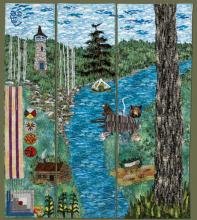A fibre art depiction of the interaction between early Mennonite settlers and Aboriginal people in the Grand River valley was on display at the Mennonite Church Canada assembly July 4-8. “My vision was to create a pictorial slice of history,” said Judy Gascho-Jutzi, the artist.
Neill and Edith von Gunten, recently retired directors of MC Canada’s Native Ministries, had seen examples of Gascho-Jutzi’s work and were inspired to ask the Mennonite Historical Society of Ontario to commission her to portray the early contact between Mennonites and the Six Nations in quilt form. They were very delighted to see their dream come true.
Flowing through the scene is the Grand River, meandering past many Mennonite and Aboriginal symbols. In the right foreground is the trunk of a black walnut, a tree valued by Mennonites. Balancing it on the left is a wampum belt with two parallel lines symbolizing cooperation. Grandmother moon, at the top left, lights up the sky and helps to give movement to the piece. The Pioneer Tower reminds us of the earliest Mennonite farmers while a large pine tree is an aboriginal symbol of peace with its roots stretching in four directions. The artist put the pine tree on a turtle because native tradition says that North America is shaped like a turtle.
At the bottom left is a quilt block in the traditional log cabin pattern. Gascho-Jutzi was delighted to find 100-year-old fabric for this quilt block. The log cabin and the Conestoga wagon are also symbolic of the early Mennonite presence while the long house and the various clan animals represent native culture. The crops (corn, beans, squash, strawberries) and the circles are common to both cultures. The medicine wheel is an important symbol for the Aboriginal people while the rosette design in the Pennsylvania Dutch hex symbol reminds us of Mennonites.
The artist also shared some of her secrets of how she achieved a three-dimensional effect. “It’s exciting to find just the right kind of fabric,” she said. She was thrilled to find just the right texture and colour for the black walnut tree, and by sewing it onto shrinkable cotton waffle cloth, she was able to get the effect of the crevices found in walnut bark. The moon and clouds are given depth by using dryer lint. She was able to include a real arrowhead that came from a farm along the Grand River due to the generosity of Margaret Woolner. The arrowhead is attached using bridal tulle. Sometimes Gascho-Jutzi is hampered by the realities of what fabric is available and she was disappointed not to find better beans.
“These projects need to speak to me and I need to feel them,” said Gascho-Jutzi. When asked why it is in three pieces, she shrugged and said that was what felt right. In response, Neill von Gunten said that the three parts make it a Mennonite wampum belt—it symbolizes working together.
The artist said it took about a year to make this quilted art. She thought about the project and began collecting fabrics last fall and then began sewing in January. She worked hard to get it finished by July.
The historical society plans to have the piece on display at Conrad Grebel University College, although it may need to wait until the construction of the enlarged library and archives is complete.



Add new comment
Canadian Mennonite invites comments and encourages constructive discussion about our content. Actual full names (first and last) are required. Comments are moderated and may be edited. They will not appear online until approved and will be posted during business hours. Some comments may be reproduced in print.